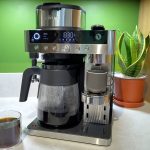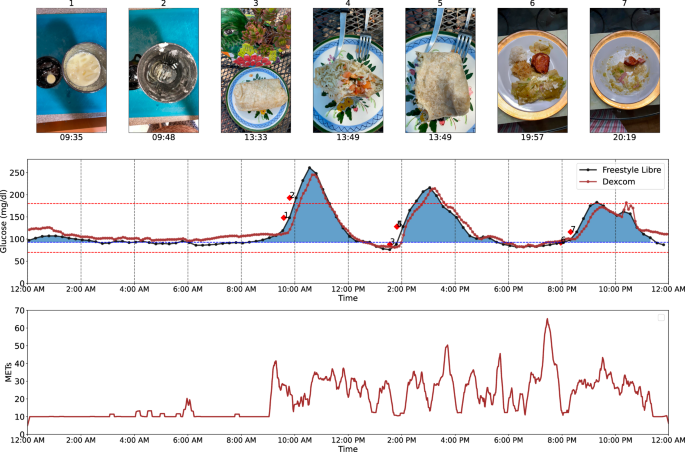Afshin, A. et al. Health effects of dietary risks in 195 countries, 1990–2017: a systematic analysis for the global burden of disease study 2017. The lancet 393, 1958–1972 (2019).
Google Scholar
Cordeiro, F. et al. Barriers and negative nudges: Exploring challenges in food journaling. In Proceedings of the 33rd Annual ACM Conference on Human Factors in Computing Systems, 1159-1162 (2015).
Bedri, A., Li, D., Khurana, R., Bhuwalka, K. & Goel, M. Fitbyte: Automatic diet monitoring in unconstrained situations using multimodal sensing on eyeglasses. In Proceedings of the 2020 CHI Conference on Human Factors in Computing Systems, 1–12 (2020).
Bell, B. M. et al. Automatic, wearable-based, in-field eating detection approaches for public health research: a scoping review. NPJ digital medicine 3, 38 (2020).
Google Scholar
from Inertial, I.-M. E. B. Modeling wrist micromovements to measure in-meal eating behavior from inertial sensor data. IEEE journal of biomedical and health informatics 23, 2325 – 2334 (2019).
Kyritsis, K., Diou, C. & Delopoulos, A. A data driven end-to-end approach for in-the-wild monitoring of eating behavior using smartwatches. IEEE Journal of Biomedical and Health Informatics 25, 22–34 (2020).
Google Scholar
Mirtchouk, M., Merck, C. & Kleinberg, S. Automated estimation of food type and amount consumed from body-worn audio and motion sensors. In Proceedings of the 2016 ACM International Joint Conference on Pervasive and Ubiquitous Computing, 451–462 (2016).
Shen, Y., Salley, J., Muth, E. & Hoover, A. Assessing the accuracy of a wrist motion tracking method for counting bites across demographic and food variables. IEEE journal of biomedical and health informatics 21, 599–606 (2016).
Google Scholar
Rouast, P. V., Heydarian, H., Adam, M. T. & Rollo, M. E. Oreba: A dataset for objectively recognizing eating behavior and associated intake. IEEE Access 8, 181955–181963 (2020).
Google Scholar
Matsuda, Y., Hoashi, H. & Yanai, K. Recognition of multiple-food images by detecting candidate regions. In 2012 IEEE international conference on multimedia and expo, 25–30 (IEEE, 2012).
Min, W. et al. Large scale visual food recognition. IEEE Transactions on Pattern Analysis and Machine Intelligence 45, 9932–9949 (2023).
Google Scholar
Salvador, A. et al. Learning cross-modal embeddings for cooking recipes and food images. In Proceedings of the IEEE conference on computer vision and pattern recognition, 3020–3028 (2017).
Thames, Q. et al. Nutrition5k: Towards automatic nutritional understanding of generic food. In Proceedings of the IEEE/CVF conference on computer vision and pattern recognition, 8903–8911 (2021).
Sajjadi, S. et al. Towards the development of subject-independent inverse metabolic models. In ICASSP 2021-2021 IEEE International Conference on Acoustics, Speech and Signal Processing (ICASSP), 3970–3974 (IEEE, 2021).
Das, A. et al. Predicting the macronutrient composition of mixed meals from dietary biomarkers in blood. IEEE Journal of Biomedical and Health Informatics 26, 2726–2736 (2021).
Google Scholar
Zhang, L. et al. Joint embedding of food photographs and blood glucose for improved calorie estimation. In 2023 IEEE EMBS International Conference on Biomedical and Health Informatics (BHI), 1–4 (IEEE, 2023).
Marling, C. & Bunescu, R. The ohiot1dm dataset for blood glucose level prediction: Update 2020. In CEUR workshop proceedings, vol. 2675, 71 (NIH Public Access, 2020).
Dubosson, F. et al. The open d1namo dataset: A multi-modal dataset for research on non-invasive type 1 diabetes management. Informatics in Medicine Unlocked 13, 92–100 (2018).
Google Scholar
Rodriguez-Leon, C. et al. T1diabetesgranada: a longitudinal multi-modal dataset of type 1 diabetes mellitus. Scientific Data 10, 916 (2023).
Google Scholar
Zhu, T., Li, K., Herrero, P. & Georgiou, P. Personalized blood glucose prediction for type 1 diabetes using evidential deep learning and meta-learning. IEEE Transactions on Biomedical Engineering 70, 193–204 (2022).
Google Scholar
Zhao, Q. et al. Chinese diabetes datasets for data-driven machine learning. Scientific Data 10, 35 (2023).
Google Scholar
Gutierrez-Osuna, R., Kerr, D., Mortazavi, B. & Das, A. CGMacros: a scientific dataset for personalized nutrition and diet monitoring. figshare (2025).
Tily, H. et al. Gut microbiome activity contributes to individual variation in glycemic response in adults. Biorxiv 641019 (2019).
Howard, R., Guo, J. & Hall, K. D. Imprecision nutrition? different simultaneous continuous glucose monitors provide discordant meal rankings for incremental postprandial glucose in subjects without diabetes. The American journal of clinical nutrition 112, 1114–1119 (2020).
Google Scholar
Zeevi, D. et al. Personalized nutrition by prediction of glycemic responses. Cell 163, 1079–1094 (2015).
Google Scholar
Chen, T. Xgboost: extreme gradient boosting. R package version 0.4-21 (2015).
Mendes-Soares, H. et al. Model of personalized postprandial glycemic response to food developed for an israeli cohort predicts responses in midwestern american individuals. The American journal of clinical nutrition 110, 63–75 (2019).
Google Scholar
Lundberg, S. A unified approach to interpreting model predictions. Advances in Neural Information Processing Systems, 30 (2017)
Berry, S. et al. Personalised responses to dietary composition trial (predict): an intervention study to determine inter-individual differences in postprandial response to foods (2020).
Ketema, E. B. & Kibret, K. T. Correlation of fasting and postprandial plasma glucose with hba1c in assessing glycemic control; systematic review and meta-analysis. Archives of Public Health 73, 1–9 (2015).
Google Scholar
Rytz, A. et al. Predicting glycemic index and glycemic load from macronutrients to accelerate development of foods and beverages with lower glucose responses. Nutrients 11, 1172 (2019).
Google Scholar
Wolever, T. M., Zurbau, A., Koecher, K. & Au-Young, F. The effect of adding protein to a carbohydrate meal on postprandial glucose and insulin responses: a systematic review and meta-analysis of acute controlled feeding trials. The Journal of Nutrition (2024).
Mortazavi, B. J. & Gutierrez-Osuna, R. A review of digital innovations for diet monitoring and precision nutrition. Journal of Diabetes Science and Technology 17, 217–223 (2023).
Google Scholar
Petrovski, G. et al. Simplified meal announcement versus precise carbohydrate counting in adolescents with type 1 diabetes using the minimed 780g advanced hybrid closed loop system: A randomized controlled trial comparing glucose control. Diabetes Care 46, 544–550 (2023).
Google Scholar
Wolfe, R. R., Cifelli, A. M., Kostas, G. & Kim, I.-Y. Optimizing protein intake in adults: interpretation and application of the recommended dietary allowance compared with the acceptable macronutrient distribution range. Advances in Nutrition 8, 266–275 (2017).
Google Scholar
link






More Stories
Forget fiber. Science just found the foods that really help constipation
Is dal a good source of protein in Indian diet: Know what nutrition experts really say |
Do Diet and Nutrition Impact Aging and Well-Being?